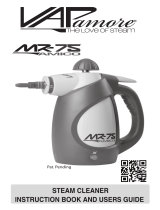APRILIA AMICO 50 - 11-1997 Owner's manual
- Category
- Motorcycles
- Type
- Owner's manual
This manual is also suitable for
APRILIA AMICO 50 - 11-1997 is a motorized vehicle well-suited for daily commuting and personal transportation. The AMICO 50 features a 2-stroke engine with a displacement of 49 cm3. It is equipped with an automatic transmission and a belt drive. The vehicle has a fuel tank capacity of 7.5 liters, of which 2 liters are reserve. The AMICO 50 has a split single beam tubular steel frame, a front fork with articulated rod, and a hydraulic monoshock absorber in the rear. It has a front disc brake with a diameter of 155 mm and a rear shoe brake with a diameter of 110x25 mm.
APRILIA AMICO 50 - 11-1997 is a motorized vehicle well-suited for daily commuting and personal transportation. The AMICO 50 features a 2-stroke engine with a displacement of 49 cm3. It is equipped with an automatic transmission and a belt drive. The vehicle has a fuel tank capacity of 7.5 liters, of which 2 liters are reserve. The AMICO 50 has a split single beam tubular steel frame, a front fork with articulated rod, and a hydraulic monoshock absorber in the rear. It has a front disc brake with a diameter of 155 mm and a rear shoe brake with a diameter of 110x25 mm.




















-
 1
1
-
 2
2
-
 3
3
-
 4
4
-
 5
5
-
 6
6
-
 7
7
-
 8
8
-
 9
9
-
 10
10
-
 11
11
-
 12
12
-
 13
13
-
 14
14
-
 15
15
-
 16
16
-
 17
17
-
 18
18
-
 19
19
-
 20
20
-
 21
21
-
 22
22
-
 23
23
-
 24
24
-
 25
25
-
 26
26
-
 27
27
-
 28
28
-
 29
29
-
 30
30
-
 31
31
-
 32
32
APRILIA AMICO 50 - 11-1997 Owner's manual
- Category
- Motorcycles
- Type
- Owner's manual
- This manual is also suitable for
APRILIA AMICO 50 - 11-1997 is a motorized vehicle well-suited for daily commuting and personal transportation. The AMICO 50 features a 2-stroke engine with a displacement of 49 cm3. It is equipped with an automatic transmission and a belt drive. The vehicle has a fuel tank capacity of 7.5 liters, of which 2 liters are reserve. The AMICO 50 has a split single beam tubular steel frame, a front fork with articulated rod, and a hydraulic monoshock absorber in the rear. It has a front disc brake with a diameter of 155 mm and a rear shoe brake with a diameter of 110x25 mm.
Ask a question and I''ll find the answer in the document
Finding information in a document is now easier with AI
Related papers
-
APRILIA RALLY 50 - 2002 User manual
-
APRILIA RALLY 50 - 2000 User manual
-
APRILIA RS 125 - 1995 User manual
-
APRILIA CLASSIC 125 - 1997 User manual
-
APRILIA RS 125 - 1996 User manual
-
APRILIA 2010 RX 50 User manual
-
APRILIA CLASSIC 125 - 03-1997 Owner's manual
-
APRILIA RALLY 50 Owner's manual
-
APRILIA SCARABEO 50 I.E 100 4T - 2002 Owner's manual
-
APRILIA SCARABEO 50 - Use and Maintenance Manual
Other documents
-
Malaguti MALBO Line User manual
-
Telair Energy 4000 B - GAS User manual
-
VESPA Grande Use Maintenance And Consumer Information
-
Amico Reflection Series Installation Instructions Manual
-
 Vapamore MR-75 User manual
Vapamore MR-75 User manual
-
Amico Chemetron Retro-Fit Manual
-
Amico Freedom Series Installation Instructions Manual
-
Amico Majestic Series Installation guide
































